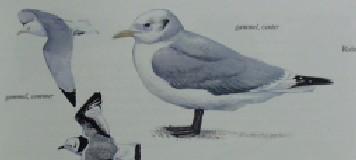
|
|
18 June, 2000
18 June 2000
Seabird Reproduction - Different Strokes For Different Folks
Today we are on our way back to the ice. We left Nuuk, Greenland this
morning and should arrive at our next test site location sometime tomorrow
afternoon. Next up is a test of the dredging capabilities of the shipís
systems before we start to work on coring. While we are on our way, and
waiting to get back to work, I spend a lot of time on the bridge or the
foredeck looking for sea life - especially birds and mammals. Birding is
something Iíve enjoyed for a long time and the arctic has many species not
found elsewhere in the world. The seabirds are especially interesting to me
because I spent some time studying them when I was in college. One of the
things I find fascinating about them is how they solve the problem of
reproducing, so today while we wait for more science to get underway here, I
ím going to give you a brief natural history lesson in seabird breeding
ecology.
Seabirds are so well adapted for living out on the oceanís waters that they
could spend their entire lives out at sea if it werenít for the problem of
where to lay eggs. So, the only time many of them return to land is to
reproduce. However, different birds solve the challenges of reproducing on
land in different ways. Letís focus on three somewhat representative
birds - Black-legged Kittiwakes, Common Puffins, and Thick-billed Murres.
These species are found in the arctic, but the first two can also be found
farther south.
Black-legged Kittiwakes (Rissa tridactyla) are small gulls that feed
primarily on fish. When they reproduce, they build a nest of plant matter,
mud, and their own droppings, on the edges of steep cliffs. A breeding pair
will takes turns incubating the one to three eggs the female laid until they
hatch. If a predator, like a large gull or raven, comes near, all the
adults will fly out and chase it off. The chicks are born with a fuzzy coat
of down to keep them warm, and the parents take turns watching them and
bringing them food. Food brought back to the nest is regurgitated by the
adult, then the chicks battle over their fish dinner. In years where
limited food is available, the older and bigger chicks survive, while the
smaller ones end up starving. It doesnít take long for the chicks to grow
big enough to fly on their own, then off to sea they go.
Common puffins (Fratercula arctica) do things a little bit differently.
Puffins have short stubby wings that prevent the acrobatic flight seen in
kittiwakes. They protect their eggs from predators by laying them in holes
in the cliff or ground. They are unable to fill up their gut and
regurgitate like kittiwakes, but they are able to catch several fish at a
time in their colorful bills. They take turns doing this while incubating
and then feeding their downy covered young, but once the chick gets to a
certain size, they both begin collecting food for it. While both parents
are out, the chick is safe back inside its little hole. Once the chick is
grown enough to fly, it heads out to sea for the food.
Thick-billed Murres (Uria lomvia), are known in Europe as Brunnichís
Guillemot, and are similar to puffins, but have a straight, black bill.
These birds have yet another variation on the strategy of reproducing on
ocean-side cliffs. Murres also breed in pairs and the female lays a single
egg which they take turns incubating. The egg is laid directly on ledges on
the cliffs and pairs literally breed side by side. There may hundreds on a
ledge, or even thousands on top of a large rock projecting out of the sea.
They are not proficient fliers and like puffins, are unable to mob predators
the way that kittiwakes do. Unlike puffins, they only bring back one fish
at a time to their young, and one adult usually stays with the chick to
protect it from predators and the harsh arctic winds. The murres solve the
problem of being able to bring a limited amount of food to the young by
bringing their young to the food. Murre chicks leave the cliffs long before
they are capable of flying. They simply jump off the cliff, encouraged by a
parent, to the sea below where they head offshore with the adults to dine a
little closer to the food source.
As you can see, each species of seabird has its own solution to coming back
to land for reproduction. Each is well suited for the strategy it uses and
they obviously work because each of the species is present in abundance
throughout the waters of the arctic realm. If you are looking for more
information about birds, try visiting your local library and looking at
field guides or books on the natural history of birds.
(Illustrations from ďGreenlands dyr og planterĒ by Benny Gensbol and Carl
Christian Tofte)

Thick-billed Murre

Common Puffin

Black-legged Kittiwake
Contact the TEA in the field at
.
If you cannot connect through your browser, copy the
TEA's e-mail address in the "To:" line of
your favorite e-mail package.
|
